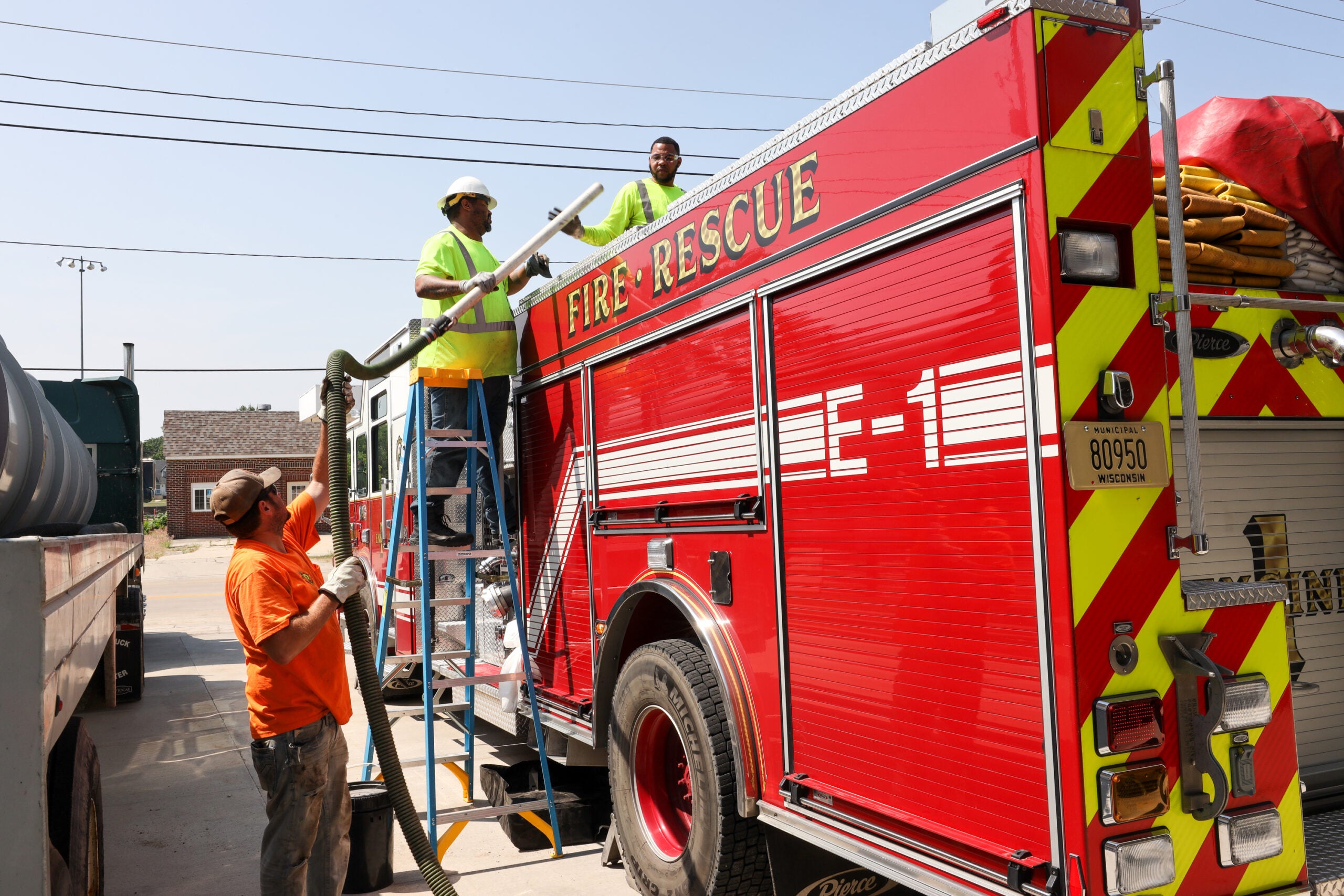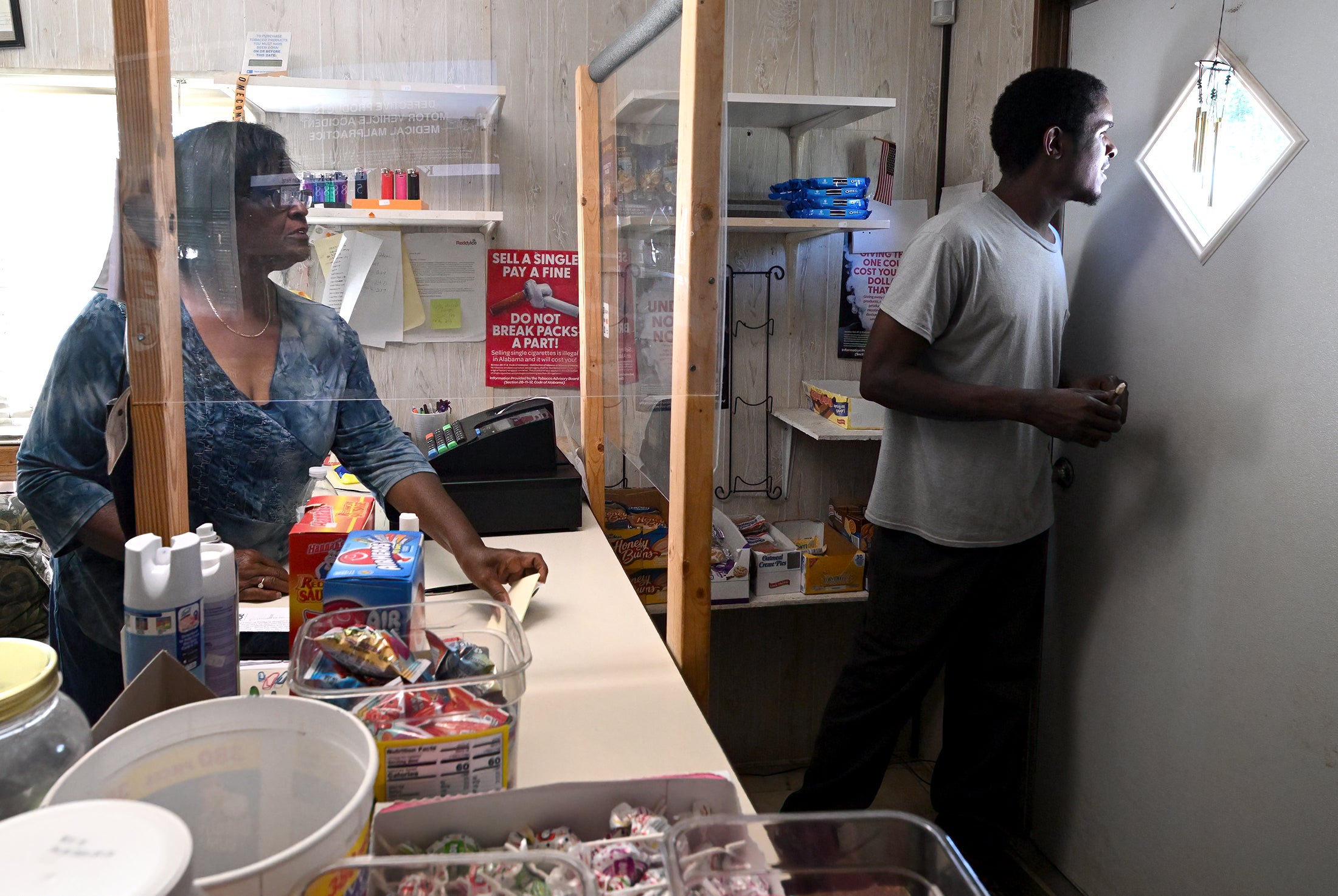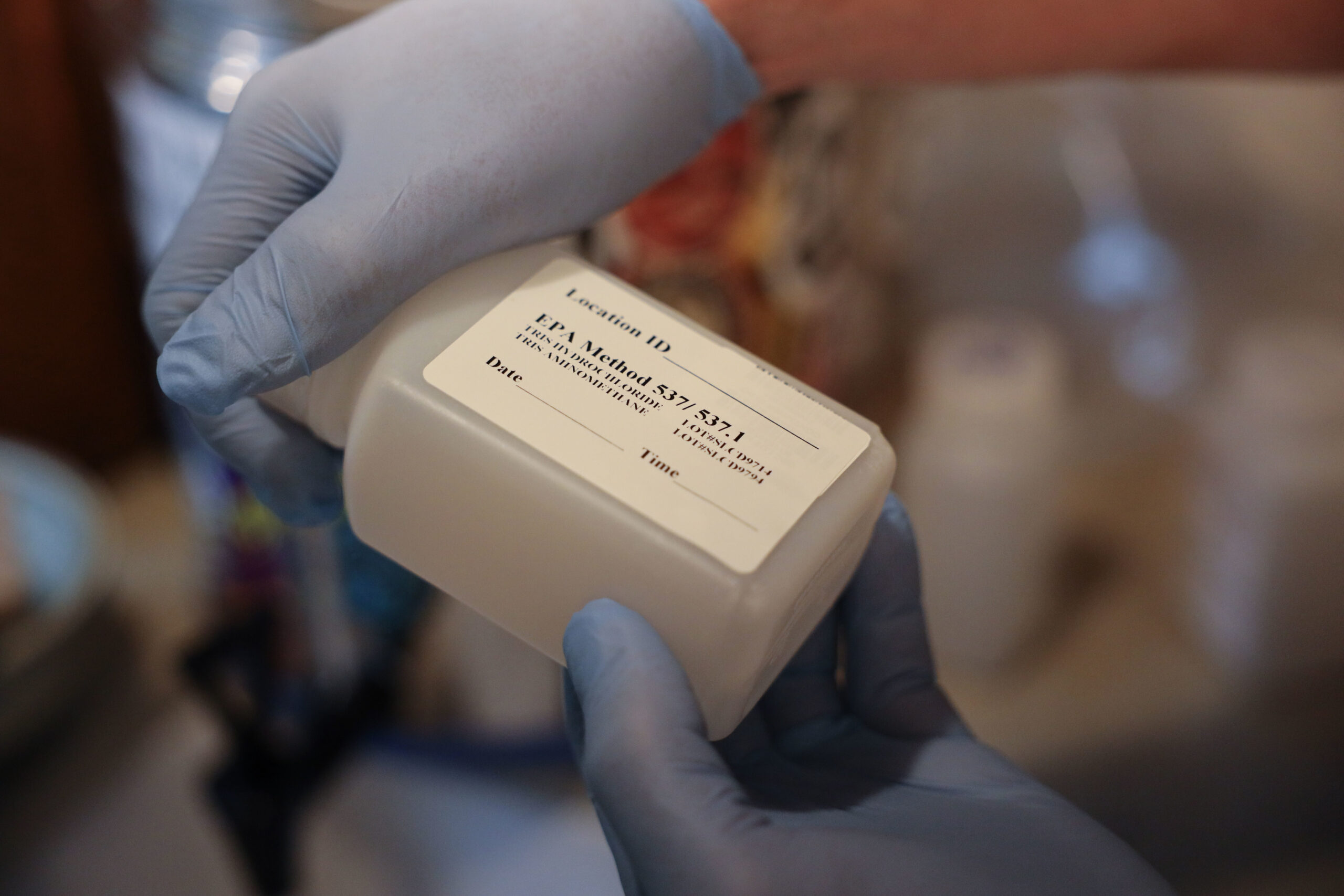Five-gallon plastic pails holding a toxic chemical linked to cancer sat for years on the shelves of a fire department in south-central Wisconsin. Finally, in a heralded statewide cleanup, they were gathered up and shipped off.
“I don’t have to worry about something being knocked over, broken open,” said Jefferson Fire Chief Ron Wegner. “So it’s just nice to have it gone.”
But where did it go?
Stay informed on the latest news
Sign up for WPR’s email newsletter.
There are no easy answers for dealing with “forever chemicals” called PFAS: a family of 12,000 human-made compounds that don’t readily break down in nature. Removed from Wisconsin, the birthplace of the modern environmental movement, means buried in Alabama, where the federal government has flagged areas as vulnerable to environmental injustice.
In Wisconsin, experts weighed the most responsible disposal solution. The state is trucking more than 38,500 gallons of PFAS-containing firefighting foam more than 700 miles to Emelle, Alabama, the home of one of the country’s largest hazardous waste landfills.
It sits in the Alabama Black Belt, rural counties historically known for fertile soil, America’s Cotton Kingdom and the slave trade. Sumter County is now home to 12,345 residents, about 70 percent of whom are Black and nearly a third of whom live in poverty. More than half are unemployed.
“A state that is predominantly white is sending its waste that’s toxic to the Black Belt,” said sociologist Robert Bullard, a Texas Southern University professor who surveyed Emelle residents in the 1980s as part of a landmark study on environmental racism in the American South. “It’s not going to a predominantly white area in Alabama.”

In 1977, relatives of segregationist Alabama Gov. George Wallace opened the landfill, which Chemical Waste Management purchased the following year. It sparked opposition from its birth, but officials have welcomed the jobs and revenue it brings.
The landfill’s entrance sits near M&M Market, a gas station and lunch counter where two old high school friends chatted on a summer afternoon. They reminisced about graduating from Sumter County High in 1973. Talk turned to rumors about the next batch of waste destined for the landfill.
“You can’t safely contain nothing that’s man-made,” said military veteran Jimmie Williams, 69. “So why bring it in here?”
He sees a lot of sickness around him like heart disease, strokes and unexplained death in young people. There is no evidence to suggest it is connected to PFAS or the landfill, but he feels in the dark.
“We don’t know,” Williams said. “We’re lost.”
PFAS cleanups left to states
Various types of PFAS — found in consumer products like nonstick pans, food wrappers and raincoats — are turning up in water nationwide. Thousands of cities and counties, and a host of states and utilities, including in Wisconsin and Alabama, have sued the 3M Company, DuPont and other manufacturers, alleging they failed to alert the public of exposure risks.
Firefighters question how to handle stockpiles of PFAS-containing, or fluorinated, foam. The U.S. Environmental Protection Agency has yet to institute disposal requirements, leaving states to decide. Some have burned the foam, which can disperse PFAS into the air.
Without a viable way to destroy the compounds, a hazardous waste landfill seemed best for Wisconsin.
But Bullard, often called the “father of environmental justice,” said transporting PFAS to Emelle disproportionately shifts the burden and risk onto a largely poor community of color. While Wisconsin can discard a piece of its PFAS problem, Sumter County residents lacked the choice of whether to accept it.
Emelle fits into a larger pattern, Bullard said. A 2007 study he led found people of color made up 56 percent of the population in neighborhoods near the nation’s hazardous waste landfills. The figure jumped to 69 percent when analyzing clusters of two or more facilities. Race independently predicted hazardous waste locations — more than income and education levels.
There has been no reported contamination of community drinking water due to the Emelle landfill, and company spokesperson Tricia Farace told reporters the facility “utilizes engineered controls to prevent impacts to groundwater and the neighboring environment.”
But Bullard says medical outcomes alone can’t measure effects.
Few people, he said, want their community to be considered America’s “waste dumping ground.”
“Harm can be measured in terms of the extent to which people are disrespected,” Bullard said.

Wisconsin launches foam collection program
About 76 percent of Wisconsin fire departments surveyed in 2020 said they possessed or previously used fluorinated foam, some dating to the 1980s. Many wanted to learn about how to get rid of it.
Two departments previously sent their foam to an incinerator, and one dumped it into the sewer.
In 2021, Wisconsin lawmakers allocated $1 million to collect the foam, and officials examined approaches in other states.
Massachusetts and Rhode Island incinerated theirs. Washington considered doing so, but withdrew the proposal in the face of public concern over pollution risks. Colorado paid fire departments to store their foam. Michigan and Indiana contracted with a hazardous waste landfill in Idaho.
Wisconsin took its cues from its Midwestern neighbors.
“We really felt like, at that time, using the hazardous waste landfill was the safest option available,” said Mimi Johnson, director of the Office of Emerging Contaminants at the Wisconsin Department of Natural Resources.
None of the country’s 60 permitted hazardous waste landfills are in Wisconsin.
The state contracted with North Shore Environmental Construction, which it previously hired to clean up PFAS spills.
Dave Johnson, the company’s executive vice president, said North Shore had long worked with and recommended Chemical Waste Management.
When North Shore contracted with the state, the company committed to avoid contributing to environmental injustice.
“You obviously don’t want to go into an area that’s going to be a disadvantage to somebody,” Johnson said.
The Wisconsin Department of Natural Resources was unaware of the Alabama landfill’s contentious history, Mimi Johnson said.

Landfill ignites Alabama protests
Multiple protesters chained themselves to a fence in protest of Emelle becoming what they called the nation’s “pay toilet.” It was November 1987, and they aimed to block waste trucks from entering the landfill.
One chained activist was a local housewife and a former Baptist Sunday school teacher. Another was a civil rights leader who had marched with Martin Luther King Jr. across the Edmund Pettus Bridge in Selma, Alabama, in 1965.
They were arrested and charged with criminal trespassing.
From the landfill’s founding, the site generated numerous demonstrations and spurred the formation of grassroots organizations. However, Chemical Waste Management also was one of the region’s largest employers, and its payments through a state waste tax provided crucial revenue for schools and county government.
Linda Munoz, an early Alabamians for a Clean Environment leader, initially had no idea the landfill had been built in Emelle, about 23 miles away from her antebellum home in the woods of Cuba, Alabama.
Munoz began to research and worried that toxic materials might leak into the aquifer below.
“Are they giving us blood money for this?” she asked this summer. “We have one of the poorest counties in Alabama and probably in the United States. So it just isn’t fair for us to be the sacrifice zone.”
‘You have to beg for what you want’
On a June afternoon, Dorothy Oliver stepped into the small mobile home she runs as a convenience store in Panola, a town of 74 about 15 miles north of Emelle.
Oliver jokes that she’s Panola’s informal mayor. People seek her help when trees fall or roads need fixing. Oliver helped bring vaccines to Panola during the COVID-19 pandemic.
“We’re in a rural, Black area in Sumter County,” she said. “You have to beg for what you want, and that’s sad.”
Oliver worked in Chemical Waste Management’s records department for three decades, and she thinks the company was well run.
But how does she feel about Wisconsin’s PFAS?
“I don’t think it’s fair for you to take your waste and ship it to an almost all-Black county,” Oliver said.
Sumter County accepted it, she said, but she can’t imagine the reverse.
“Wisconsin would have said, because they’re majority white, they would have said, ‘We ain’t going to have it,’” Oliver said,

Landfill handles most toxic waste
The Emelle landfill’s approximately 130 employees work on a 2,630-acre campus surrounded by a chain link fence. Signs warn, “Danger, Unauthorized Persons Keep Out.”
One active landfill trench at the site could hold 1 ½ times as much waste as could fit inside the Great Pyramid of Giza. Nearly two dozen more trenches are filled and closed.
The facility receives “virtually every type” of regulated hazardous and toxic waste. All of it arrives by truck, usually semitrailers.
Some containers are stored in corrugated metal buildings before they are transferred, treated or buried. Hundreds of plastic and steel drums fill the interior aisles, sometimes stacked two high, atop concrete and stainless steel floors.
Mike Davis, the landfill’s senior district manager, said the facility expects more PFAS to come.
“A lot of people don’t know what to do because there hasn’t been any direction given yet,” Davis said. “So the best thing to do is send it to a facility like ours, and we manage it correctly.”
Chemical Waste Management calls the 600 feet of “Selma Chalk” limestone atop which the Emelle landfill sits virtually “impermeable.” Any spills, the company argues, would take millennia to reach the aquifers below. Additional safeguards should prevent any chemicals from leaving the trenches.
Several use special liners that collect leachate, fluids generated when liquids percolate through waste. The leachate is pumped to colossal tanks for treatment, after which it is mixed with a substance like kiln dust or fly ash that forms concrete when water is added. The resulting material is buried on site.
Emelle’s operators tout the landfill’s robust system of protections, but it’s not perfect.
Twenty trenches, many dating to the late 1970s, use no base liner other than compacted chalk or clay. Several leak.
As early as the 1980s, monitoring wells detected toxic chemicals within the vicinity of the facility’s first six trenches, which stored corrosive waste, toxic metals, ignitable materials, herbicides and pesticides, wastewater sludge and polychlorinated biphenyls, or PCBs.
As the trenches were excavated, workers installed a chalk cutoff wall to minimize the movement of contaminants through groundwater, but continued monitoring also has detected the toxic chemicals in the soil and groundwater outside the wall’s perimeter.
Chemical Waste Management attributes their presence to mishandling and spills during waste disposal, not trench leaks, and insists the chalk wall has halted leaching.
State regulators flag violations
Meanwhile, the Alabama Department of Environmental Management has recently documented multiple violations.
More than two dozen containers of hazardous waste were found rusting or damaged, and 16 more were leaking, according to an April report. Inspectors observed an uncleaned spill, approximately two years old, from a leachate storage tank. A concrete floor on which mercury containers were stored was cracked, the report added.
Landfill management disputed many of the findings — no containers were damaged or leaking, they said, and spots inspectors thought were spills were stain residue. Other violations were corrected.
State and federal inspectors also recently found that the company failed to maintain records of PCB waste and properly label containers. Inspectors struggled to identify items, which had been “randomly stored,” intermingled with other types of hazardous and non-hazardous materials.

America must reckon with its refuse
Depositing fluorinated foam in a hazardous waste landfill is “a step in the right direction,” said professor Rainer Lohmann, who directs the University of Rhode Island’s STEEP lab, which researches PFAS effects.
But landfills would better be viewed as a PFAS “storage facility” than a means of disposal, he said.
Modern hazardous waste landfills are designed to last for centuries, with double liners, leak detectors and collection and treatment systems for leaching waste. Yet the EPA acknowledges that all landfills represent a potential contamination source after closure.
“Even the best landfills at this stage,” Lohmann said, “they will start failing.”
Dave Johnson of North Shore expressed confidence in Chemical Waste Management’s safety controls and experience. But one day, America must reckon with its refuse, he said.
Johnson called Bullard’s remarks “very fair.”
“Really all we’re doing in this country is just putting our waste into centralized locations,” he said. “At some point, all these landfills are going to have to be dealt with.”





